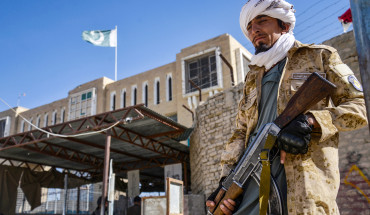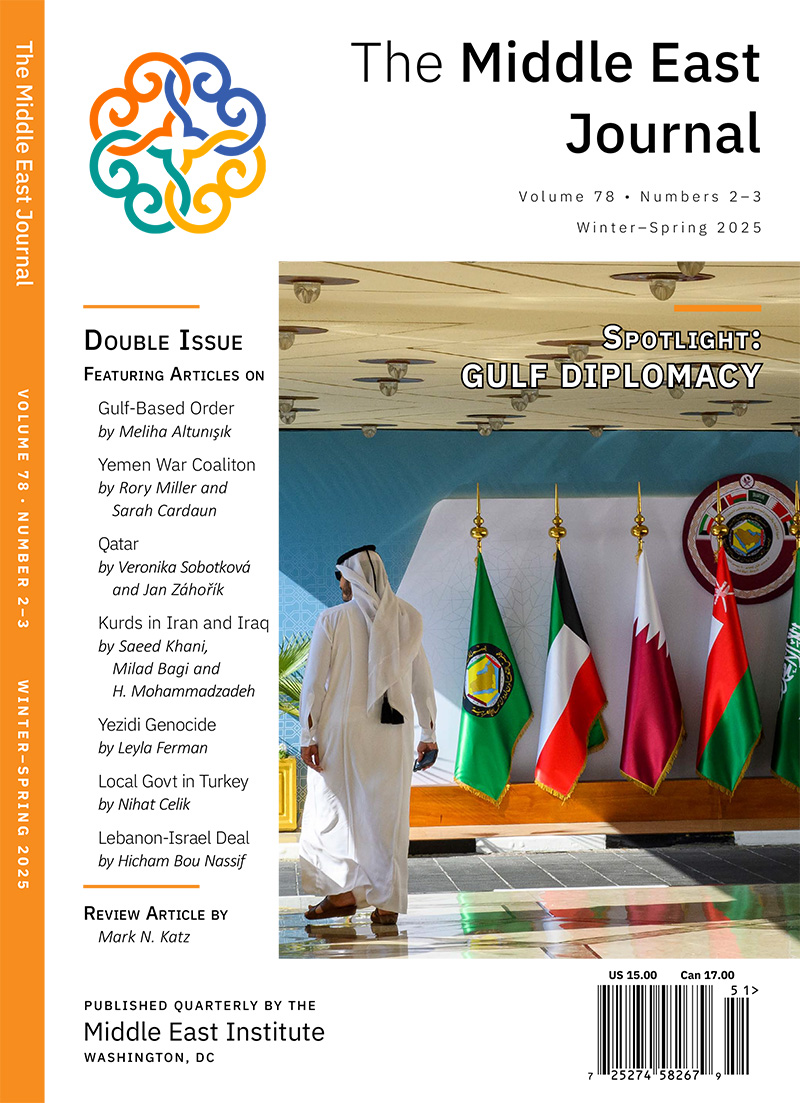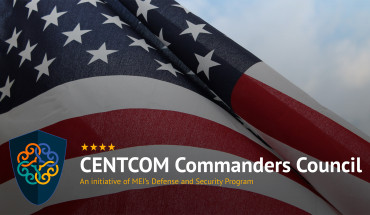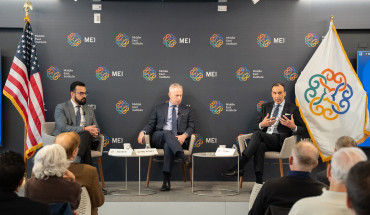
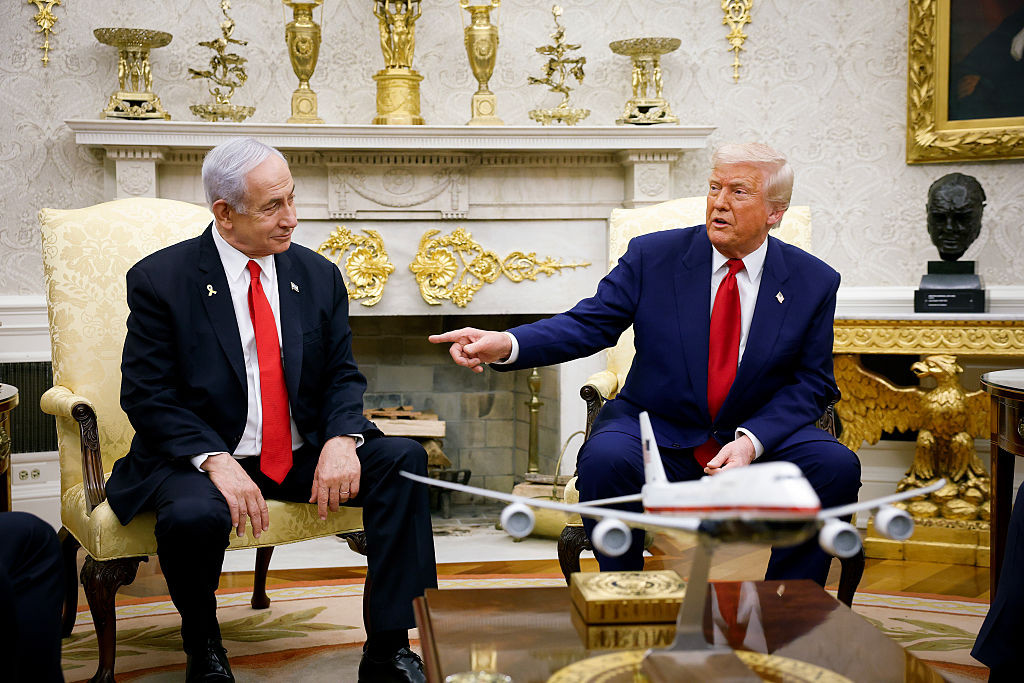
Six months into his second term, President Donald Trump remains in search of a major, concrete foreign policy win. Trump 2.0’s foreign policy is still struggling to produce a major positive outcome from its frenetic activity trying to end kinetic wars while prosecuting an unprecedented economic war with much of the rest of the world. The whirlwind of uncertainty since Trump returned to office in January has yet to improve America’s overall strategic position in the world.
The following report assesses the US government’s actions over the past three months from May to mid-July 2025. It represents the independent analytical judgments of one analyst at the Middle East Institute based on his policy research and research support from key colleagues, as well as the independent feedback from colleagues in a peer review process. It is part of a regular, quarterly assessment that includes a report card with grades on five key policy areas based on long-standing US national security interests in the Middle East and priorities set by the current US administration.
I. Executive Summary
-
This report is part of a regular, quarterly assessment that includes a report card with grades on five key policy areas based on the United States’ leading national security interests in the Middle East and priorities set by the current US administration. Some of the principal long-standing interests for America in this part of the world include energy security, support for US partners, regional stability, freedom of navigation, prevention of war, counterterrorism, containment of Iran, and non-proliferation. Priorities set by the second administration of President Donald Trump include deterring Iran, countering terrorist networks, and expanding economic and technological cooperation with key partners.
-
The following report assesses the US government’s actions over the past three months from early May to mid-July 2025. It represents the independent analytical judgments of one analyst at the Middle East Institute based on his policy research and research support from key colleagues, as well as independent feedback from colleagues in a peer review process.
-
Six months into the second Trump administration, the Middle East featured more prominently in the second quarter than it did during the administration’s first three months. This May-July 2025 period was one of high operational tempo for the United States and included:
-
President Trump’s visit to Saudi Arabia, Qatar, and the United Arab Emirates in mid-May, a trip that included a major policy shift to lift sanctions on Syria and meet with its current president and former rebel leader, Ahmed al-Sharaa, and agreements on technology and artificial intelligence (AI) cooperation that represent a major geopolitical and geo-economic development.
-
US military strikes against Iran’s nuclear sites on June 22, along with US support for a 12-day Israeli military campaign targeting Iran’s nuclear program and military leadership and infrastructure.
-
Diplomacy in the region led by prominent Trump envoys Steve Witkoff and Tom Barrack aimed at achieving another Israel-Hamas cease-fire in Gaza, building ties with new leaders in Syria and Lebanon, and five rounds of talks with Iran that were derailed by Israel’s attack on Iran on June 13.
-
-
The impact of these major actions by the United States in the Middle East remains mixed. Washington’s close partners in the region, particularly the countries Trump visited in May, have seen new opportunities to deepen strategic, economic, energy, technological, and military ties with the US. However, the impact of Trump’s tariffs and broader trade war may ultimately undercut these openings to strengthen bilateral ties and could incentivize those regional partners to diversify their global economic relationships.
-
Iran’s nuclear and military infrastructure suffered considerable damage in the mid-June Israeli and US strikes, but it is unclear if these actions will result in a lasting resolution to concerns about Iran’s nuclear program and destabilizing actions. US engagement in Syria and Lebanon offer some signs of hope for progress, but this will require sustained diplomatic effort. The weakest link in US policy in the Middle East is the Israeli-Palestinian front, as the war between Israel and Hamas continues after the collapse of the cease-fire on March 18.
-
Iran, Israel-Palestine, and the Houthis in Yemen remain the three major unresolved variables in the Middle East equation, while Syria and Lebanon represent key openings for US policy in the months ahead.
-
Trump’s overall foreign policy approach in this three-month period was characterized by transactional diplomacy, selective military engagement, and attempts to use America’s economic power to gain leverage around the world. Trump’s modus operandi has stressed burden-sharing with global partners, skepticism of international institutions like the United Nations, and a continued campaign to fundamentally alter US national security institutions.
-
Trump’s July 2025 budget and tax bill represents a substantial shift in priorities away from traditional national security institutions, a massive increase in funding for harsh immigration policies, and large decreases in funding for science and America’s social safety net. The broader formula for governance outlined in this year’s budget reduces investments in tools the United States has utilized for decades to engage the broader Middle East, particularly with diplomacy and development aid. These moves, combined with the massive personnel cuts to key national security institutions like the State Department and intelligence agencies, will likely have a detrimental effect on America’s capacity to shape and influence outcomes in the Middle East.
-
Bottom line: Trump 2.0’s approach to the Middle East from May to July 2025 did damage to and imposed costs on certain adversaries, and it offered some reassurance for key regional partners. But it has not yet produced the more durable and sustainable security environment needed to meet the economic and regional integration aspirations articulated in the president’s May 2025 trip to the Gulf.
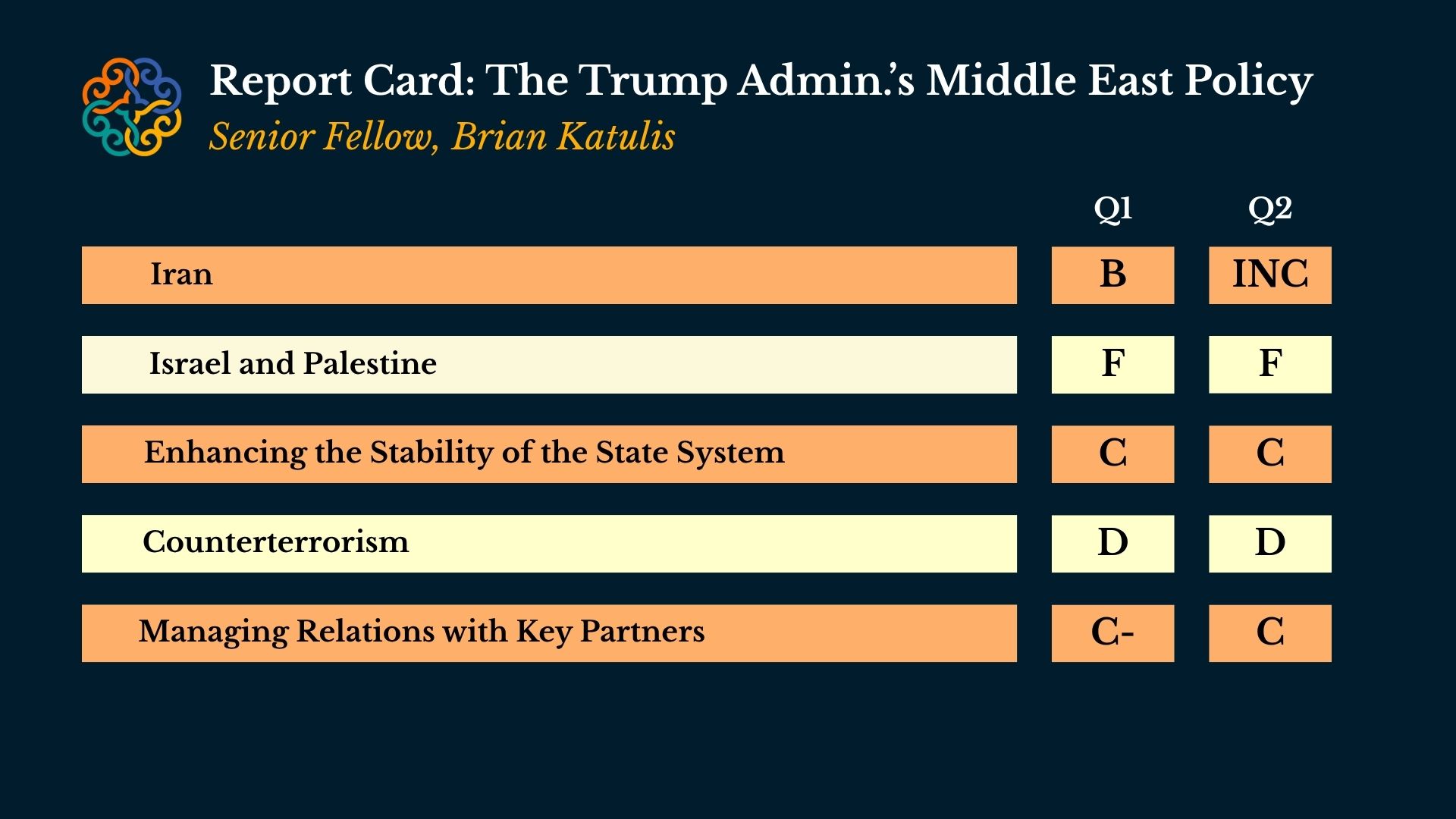
II. Trump 2.0's Overall Foreign Policy Approach
Six months into his second term, Trump remains in search of a major, concrete foreign policy win. Trump 2.0’s foreign policy is still struggling to produce a significant positive outcome from its frenetic attempts to end kinetic wars while prosecuting an unprecedented economic war with much of the rest of the world. The whirlwind of uncertainty that has prevailed since Trump returned to office in January has yet to improve America’s overall strategic position globally, but his administration has worked hard to frame its broader agenda as part of an “America First” approach in its public messaging.
Some modest gains for US national security in the first six months of Trump’s second term included:
-
Mineral wealth deal. An agreement with Ukraine in April established a reconstruction and investment fund that will give the US access to Ukraine’s reserves of critical minerals and natural resources once the war concludes.
-
Multiple economic deals in the Middle East. President Trump’s visit to the Gulf in May resulted in major economic and technology deals with regional players along with a new US policy approach on Syria.
-
India-Pakistan deal. In May, India and Pakistan agreed to a cease-fire deal that the Trump administration helped broker. However, India continues to reject the claims that the agreement was facilitated by Trump, stating that the conflict ended because all of its objectives were met.
-
Increased NATO spending pledges. North Atlantic Treaty Organization (NATO) allies committed in their June summit to increase their defense and security spending contributions to 5% of GDP by 2035. This commitment will require NATO allies to reallocate sizable defense resources — a process that may be hindered by individual debt levels, each country's ability to absorb increases in defense spending, and domestic politics over funding decisions.
-
Rwanda-Congo peace deal. Trump’s second-term diplomacy saw some progress with the June 27 announcement at the White House of a peace deal between Rwanda and the Democratic Republic of the Congo. This central African agreement is a priority for the Trump team in part because of the region’s vast wealth of critical minerals — and America’s competition with China for those resources.
The main shortcomings in the first six months of Trump’s second term included:
-
No end to Russia’s war against Ukraine. President Trump made ending Russia’s war against Ukraine a priority from day one and sent top administration officials to engage in diplomacy aimed at ending the conflict. However, throughout the second quarter, Russia continued to attack Ukraine and gathered forces in key parts of the country as Trump’s peace efforts failed. In mid-July, the administration shifted its approach, announcing new weapons shipments to Ukraine and additional sanctions targeting Russia as President Trump issued a 50-day deadline for reaching a peace deal. Russia stepped up its attacks against Ukraine after Trump announced the deadline. During his trip to Scotland at the end of July, Trump set a new deadline for Moscow to agree to a deal, shortening it to “10 or 12 days.”
-
Unclear outcomes from trade wars. Dozens of countries around the world continued to seek trade deals with the United States as Trump’s shifting deadlines for implementing costly tariffs loomed. His plan to implement steep global tariffs has not yet fully come into view, and this past quarter Trump bought more time for trade negotiations and extended deadlines for reaching deals. On July 22, Trump announced a trade deal with Japan that places a 15% tariff on Japanese goods imported to America, lower than the 25% he previously had threatened to impose. The deal also included a commitment by Japan to invest $550 billion in the United States, although some in Japan raised questions about the details of this commitment. In late July, the United States and the European Union announced a trade deal with a 15% baseline tariff rate, excluding steel, which will continue to be subject to a 50% tax. As part of the agreement, the EU committed to purchasing US energy totaling $750 billion, with $600 billion in investments into the US, over the course of three years — marking a bigger trade deal for Trump than the one reached with Japan.
These efforts were part of Trump’s overall agenda of aiming to reduce US reliance on foreign markets and enhance supply chain security, but they will have unpredictable consequences for US relations with key partners and America’s overall competitiveness. The World Bank issued a forecast on June 10 projecting a weakening international outlook due to trade tensions.
-
Absence of a clear strategic approach on China. Throughout the second quarter, the Trump administration did not put forward a coherent strategic approach to China, America’s leading competitor. Key questions about military and economic ties remain unanswered six months into the second Trump administration.
Other notable priorities on the national security front of the first six months of Trump’s second term included:
-
Harsh immigration policies. Trump’s early actions to enforce severe policies of detention, forced deportation, and family separations combined with billions of dollars committed in the July 2025 budget bill have been reshaping America’s approach on immigration, with significant potential impacts on diplomatic relations with the rest of the world.
-
Changes in US national security institutions. The Trump administration initiated major cutbacks in the US institutions of diplomacy, global economic development, and strategic communications. The efforts by the Department of Government Efficiency (DOGE) created in the early days of the Trump administration produced further drastic cuts in key institutions like the State Department and have included the elimination of organizations like USAID and Voice of America. The dismantling of these institutions decreases US soft power abroad and may allow adversaries, like China, to fill the void and expand their own influence in key geopolitical arenas.
-
Deep cuts in investments in scientific research, clean energy, and the social safety net. The July 2025 budget bill passed by Congress will continue to reshape America’s political economy and approach to the world. Earlier in the spring, the United States lost its perfect Moody’s credit rating as concerns about the national debt increased. A major fight over this bill broke out between Trump and Elon Musk, the world’s richest man and the architect of DOGE, and the broader implications of this new policy approach will reverberate inside of America and around the world for years to come.
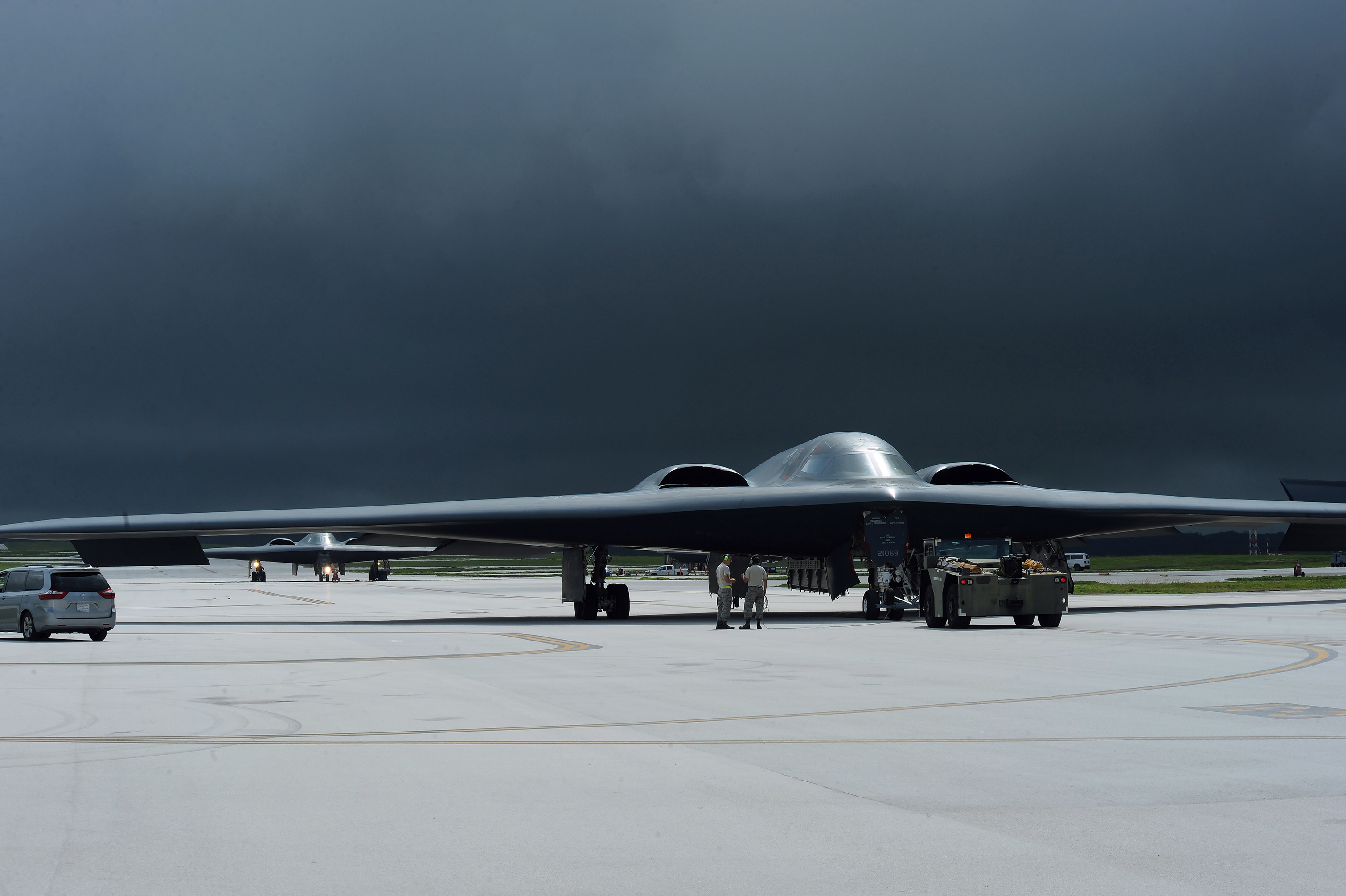
III. Trump 2.0's Middle East Approach
Iran
Overall Grade for the Quarter: Incomplete. The 12-day war by Israel and one set of military strikes by the United States in June did extensive damage to Iran’s nuclear program, but it remains unclear whether the regime has shifted its stance on enrichment or whether it will pull back from its efforts to undercut regional stability.
-
America’s core interests: In the short term, America’s main goal is to defend itself and its regional partners from threats presented by Iran. In the longer term, the main strategic interests are to prevent Iran from obtaining a nuclear weapon and to deter its destabilizing actions across the region and around the world.
-
Israel’s military campaign against Iran along with US strikes in June did extensive damage to the Islamic Republic’s nuclear program and military capabilities. But the strategic results remain inconclusive given the unanswered questions about the war’s overall impact on the regime’s capacities, will, and future intent to pursue a nuclear weapons program. Questions about Iran’s capacities encompass its ballistic missile arsenal as well as ability to undercut regional and global security with its vast terror network, cyberattacks, and regional proxies, including the Houthis in Yemen.
-
Iran remained a central focus of Trump’s Middle East policy during the second quarter, even prior to the outbreak of the 12-day war. Reflecting a continuation of his hardline stance from his previous administration, Trump advocated for a maximum pressure campaign aimed at curbing the regime’s nuclear ambitions and destabilizing regional proxies through intensified sanctions targeting Iran’s financial networks and oil exports.
-
The Trump administration engaged in several rounds of negotiations with Tehran until mid-June, when Israel conducted military strikes against Iran and the United States joined in the campaign. It remains unclear whether there is a plan for diplomacy that blocks Iran’s path to a nuclear weapon. Several challenges stand in the way of a successful diplomatic track. The first is the absence of a clearer assessment of Iran’s current capabilities, including the status of its nuclear program. The second is the massive trust and confidence gap that exists between Iran, America, and Israel, which was exacerbated by the perceived US subterfuge around negotiations and the launch of the Israeli strikes. A third challenge is Trump 2.0’s at best mixed performance and track record on diplomacy thus far.
-
What to monitor: The main focus now is on how the Iranian regime will respond and whether it will seek a pragmatic pathway to diplomacy or will continue to undercut regional and global security. A key factor to monitor will be whether the Trump administration has the ability to craft a comprehensive strategy toward Iran that coordinates with leading regional partners, including Israel and the Arab Gulf states. Its diplomatic approach will need to be backed by regional security guarantees that produce a pathway to deterring Iran from pursuing a nuclear weapon or persisting with its destabilizing regional proxy networks. Iran is strategically weakened but remains tactically and operationally lethal — it is down but not out.
Israel and Palestine
Overall Grade for the Quarter: F. The efforts to achieve a cease-fire and hostage-release deal fell short again, amidst a deteriorating humanitarian situation in Gaza and impasse over necessary concessions from both Israel and Hamas to reach a deal.
-
America’s core interests: In the short run, the immediate objectives are to achieve a cease-fire and release of hostages held by Hamas while improving the humanitarian situation. In the long run, the interests include advancing a lasting and just peace in a two-state solution framework, facilitating wider regional integration, and enhancing the security of close regional partners such as Israel, Jordan, and Egypt.
-
The Israel-Palestine file is the weakest link in Trump 2.0’s overall Middle East approach, and statements and gestures by some officials in Trump’s second administration that appear to move America away from a commitment to a two-state solution undercut America’s security interests in the long run.
-
Trump came into office with a cease-fire between Israel and Hamas in place, but that collapsed in mid-March as Israel launched an ongoing military campaign and announced its intention to seize control of 75% of Gaza. After a period of talks between Israel and Hamas in July, the US withdrew its mediation efforts after special envoy Steve Witkoff cited Hamas’ “lack of desire to reach a cease-fire deal in Gaza.” US, Qatari, and Egyptian negotiators issued a joint statement declaring that these talks were only suspended to allow for further consultations. Prime Minister Benjamin Netanyahu announced that Israel, along with its US allies, is “considering alternative options,” adding more uncertainty to the timeline for resuming talks.
-
Trump’s policy continued to reflect a pro-Israel stance, consistent with his first administration’s recognition of Jerusalem as Israel’s capital and support for Israeli sovereignty claims. Trump met with Netanyahu a third time in Washington, DC, in early July, demonstrating an interest in continuing close coordination with Israel. US ties with Palestinian leaders have been weak.
-
Worsening human security conditions in Gaza and failed diplomatic attempts to reach another cease-fire and hostage-release agreement between Israel and Hamas have hampered America’s ability to advance broader regional normalization between Israel and countries such as Saudi Arabia. News reports reveal that Gaza is reaching near-famine levels, with the number of households experiencing hunger having doubled between May and July of this year, after Israel halted the distribution of international aid into the enclave earlier this spring. Israel announced in late July that it would establish secure routes for aid distribution and suspend military activity between certain windows of time every day, until further notice. President Trump publicly recognized the “real starvation” occurring in Gaza and has since pledged that the US will work with its European allies to organize food centers.
-
Progress toward normalization remains unlikely without some important missing ingredients: a lasting cease-fire and hostage-release deal and a pathway toward a two-state solution between Israelis and Palestinians.
-
What to monitor: The key question is whether the Trump administration has the commitment and capacity to develop a plan that responds to the regional consensus in favor of a long-term two-state solution. Leading Arab countries, including Saudi Arabia, the United Arab Emirates, Egypt, Jordan, and Qatar, have offered to provide support to reconstruction and recovery in Gaza but also lasting measures to strengthen the framework for a two-state solution. Another central issue to monitor is the status of Hamas, a terrorist organization and political movement that still holds some Israelis hostage in Gaza and rejects Israel’s existence.
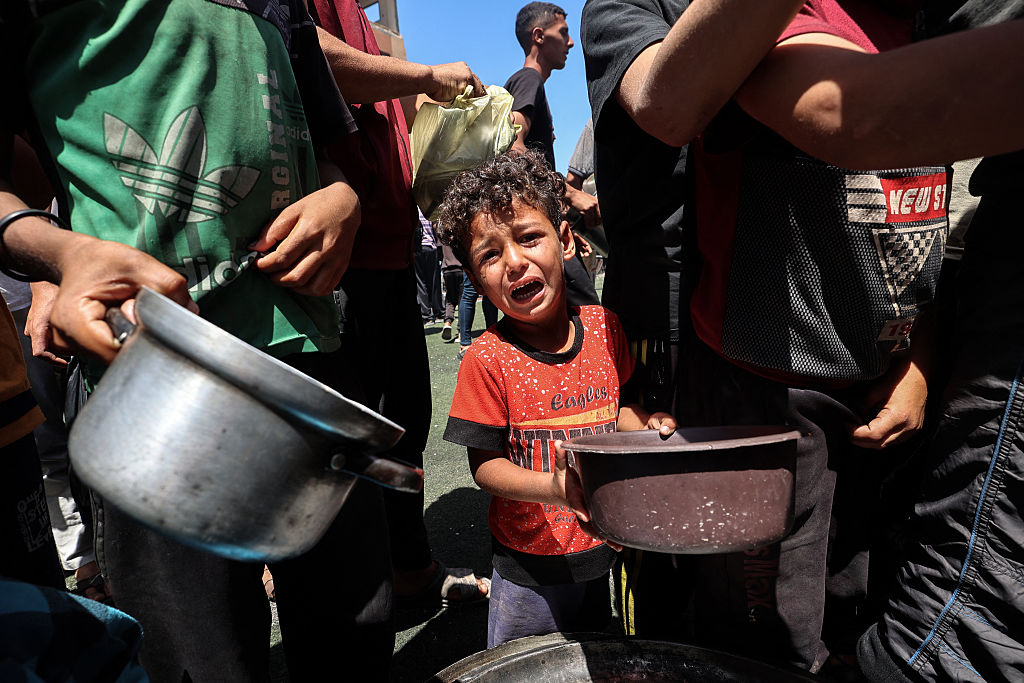
Enhancing the Stability of the State System
Overall Grade for the Quarter: C. Trump’s moves to support the nascent government in Syria were an important step forward, but the lack of a major breakthrough or significant progress in Lebanon, Yemen, and Iraq continue to hold back broader efforts by the United States to stabilize the region.
-
America’s core interests: To avoid prolonged military engagements driven by state conflict and instability in the region. The main foundations for a stable Middle East state system are individual states that have the capacity and will to defend their people and their borders. For decades, broader regional stability in the Middle East has been undermined by state weakness, failure, and sectarian and ethnic divisions within states that led to civil wars and prolonged conflicts. The Islamic Republic of Iran’s long-standing support to non-state groups, including militias in Iraq and sub-state actors like Hizballah in Lebanon, undermine the broader regional state system, but Iran’s weakened strategic position during 2024 and early 2025 presents an important opportunity to enhance regional stabilization.
-
Syria: A major shift in US policy opens up new possibilities. President Trump’s decision to lift sanctions on Syria represents an important strategic shift that enables key regional actors to create an incentive framework for the new authorities in Damascus. In turn, Trump’s meeting with President Sharaa during his trip to Saudi Arabia in May sent a clear signal that the United States supports efforts by its regional partners to help the Syrian government respond to its people’s interests in improving the economy and providing security under the framework of inclusive governance. However, recent episodes of violence, especially the conflicts between Druze and Arab communities in the south in the early summer of 2025, show how difficult it will be to help ensure diverse communities find the right pathway to live together in a unified Syria. Component Grade: B
-
Lebanon: Steps in the right direction to support the new government. The US continues to engage Lebanon’s leaders and encourage them to implement commitments made in the November 2024 cease-fire deal with Israel. Israel’s targeted military actions inside of Lebanon combined with its continued occupation of Lebanese territory in contravention of the agreement undercut the credibility of the Lebanese Armed Forces and new government, but top US officials like Ambassador Tom Barrack continue to engage Lebanese authorities and seek progress with Israel. Component Grade: C
-
Yemen: An inconclusive military campaign against the Houthis. The Trump administration conducted a military campaign from mid-March to early May against the Houthis in Yemen. This campaign damaged the militant group’s operational capacity but failed to restore security in the Red Sea or produce a pathway for long-term stability in the country. Trump announced a cease-fire arrangement in early May according to which the US would stop strikes against the Houthis and the Houthis would commit to halting strikes against Red Sea shipping or regional countries such as Israel. However, the Houthis quickly reiterated their intentions to continue to target Israel and struck additional cargo vessels in the ensuing weeks. More recently, the group vowed to escalate its Red Sea shipping attacks by targeting companies’ ships that engage in business with Israeli ports, regardless of the nationality under which the ships are flagged, in an effort to ramp up its campaign against Israel. Component Grade: D
-
Iraq: Questions about a possible US troop withdrawal. During May-July 2025, the second Trump administration did not focus as much on Iraq as on Yemen and Lebanon, and many questions exist about the future of US engagement there as the country heads to its next national election this fall. Component Grade: Incomplete
-
What to monitor: Syria represents the biggest shift on Middle East policy for the second Trump administration thus far, and it holds out the most promise of paying dividends — if Syria moves forward on a path to greater stability and prosperity. Key questions remain about how US cuts to its own structures of soft power, and the possible additional withdrawals of American troops from the region, particularly in northeastern Syria, might impact broader regional stability.
Counterterrorism
Overall Grade for the Quarter: D. The Trump administration’s approach to counterterrorism amounted to airstrikes without a broader overarching strategy to strengthen the stability of key areas suffering from the presence of extremism in the face of weak state structures, particularly Yemen and Palestine.
-
America’s core interests: To prevent an attack on the homeland and protect key Middle East partners from attacks by terrorist networks. Counterterrorism under Trump during this second quarter focused on targeted military operations combined with enhanced military intelligence cooperation with partners like Israel, which has continued to conduct strikes against a range of terrorist groups, many aligned with Iran. The impact of the attacks by Israel on Iran and against Iran’s networks degraded but did not eliminate their capacity to undercut regional stability.
-
The Trump administration also conducted limited airstrikes, including precision attacks on Islamic State (ISIS) remnants and jihadist groups in Syria and Iraq, and it continued to use sanctions and financial controls in efforts to disrupt terror financing networks.
-
The lack of an overarching strategy for stabilization in the region — particularly no clear end game in sight for the Gaza war — hinders the broader efforts to counter terrorist networks. The unresolved situation with Palestinians in Gaza, the West Bank, and East Jerusalem also continues to fuel propaganda campaigns by terrorist adversaries.
-
What to monitor: The overall US approach on other key files — Iran, Israel-Palestine, and enhancing the stability of the state system — have a direct impact on the nature of the terrorist threats America and its partners will continue to face across the region and the world. Achieving positive outcomes on those fronts will make America more secure from terrorist threats, and enhancing relations with key Middle East partners is also important for improving America’s counterterrorism strategy.
Managing Relations with Key Partners
Overall Grade for the Quarter: C. Trump’s May visit to three key Gulf partners solidified partnerships, and his support to Israel remained unstinting. But his overall economic approach, combined with cuts to US diplomacy and development aid, have presented challenges for maintaining stable partnerships.
-
America’s core interest: To support a network of partners who are capable of sharing the burdens of securing the region and working together to reach its maximum potential in producing greater prosperity through increased cooperation and connectivity.
-
Trump’s May visit to Saudi Arabia, the UAE, and Qatar reaffirmed that the Middle East remains an important arena for geopolitical competition and the global economy. The president’s unconventional economic statecraft combined with an organized media blitz sent a message of reassurance to key US partners in the region. The trade mission focus of Trump’s trip set a framework to seize new opportunities for commerce and business. But all of those visions of a new relationship with the Middle East will remain unrealized without a realistic and pragmatic approach to deal with the thorny security challenges that still loom large across the region.
-
As with Trump’s 2017 visit to the Middle East, the detailed follow up on key agreements announced in his spring 2025 trip will be essential, a task made more difficult by shifts in key US personnel working on the Middle East in the first few months of Trump’s second administration. Furthermore, issues like the controversy generated by Qatar’s gifting of a luxury jetliner to the United States during Trump’s trip to the region, particularly the ethical and legal concerns raised by Republicans and Democrats alike in Congress, may overshadow the potential for broadened economic ties between the United States and key economic powers in the region.
-
US support to Israel in its ongoing military campaign against Iran and its Axis of Resistance network also helped improve the grade that the Trump administration received in the second quarter of 2025 on managing relations with key Middle East partners.
-
What to monitor: How the sum of Trump 2.0’s broader foreign policy and geoeconomic agenda, including the impact of tariffs and trade wars, shifts the overall quality and nature of relations with key Middle East partners, merits watching.
IV. Key Analytic Judgements
-
Transactional diplomacy can achieve short-term results but could have long-term costs. The overall ledger of Trump 2.0’s foreign policy at the six-month mark is mixed, which is not unusual this early in a new US administration. On the one hand, the president’s unconventional style and transactional approach to diplomacy achieved some notable results in the form of trade deals and agreements to cooperate on elements of its harsh immigration policies. But on the other hand, this approach may not lend itself to building long-term relationships of trust and confidence and could result in numerous countries hedging against the risks and uncertainties associated with this new and potentially fleeting US approach.
-
Strategic communications and public relations are not an adequate substitute for concrete results that improve security conditions. President Trump and his team have a strong inclination to focus on strategic communications and media campaigns aimed at shaping perceptions, even if those campaigns are not fully supported by the facts. The gap between propaganda and reality is a dangerous one. For example, after the US strikes on Iran, President Trump and some members of his team said the strikes “obliterated” Iran’s nuclear program as part of its messaging campaign. The definition of “obliterate” is “to remove from existence; to destroy utterly all trace, indication, or significance of”; the strikes do not appear to have met that high standard. Undoubtedly, Iran has suffered a major setback in its nuclear program, but worrisome evidence persists that the regime retains capacities on the nuclear front.
-
Personnel is policy, and personnel keeps shifting. Key US partners in the Middle East are likely to continue working closely with the administration, but reassignments in mid-level and senior personnel, recent cuts at the State Department, shifts at the Pentagon and inside of the intelligence community, and the vacancies in key embassies around the region could hamper the reach and impact of US policy. During this period, the Trump administration continued to make shifts in key senior staff positions, including a new senior director for the Middle East at the National Security Council reportedly onboarding this spring after Trump’s trip to the region and a subsequent purge and reassignment of key personnel. These staffing changes seem to reflect the overall uncertainty that is at the heart of Trump 2.0’s approach to the world and to America as it arrives at its six-month mark in office.
-
“Divide-and-conquer” domestic politics and global diplomacy may ultimately reduce US power and influence. America is led by a president who engages in the politics of division and subtraction. He consciously splits people into different camps in order to create more leverage to push through presidential actions. But this fragments and shrinks the coalitions needed to take on big challenges like finishing the work left undone on Iran or the Israel-Palestine file. Trump’s domestic opposition engages in similar tactics, which deepens the rift in the country and increasingly leaves a growing number of Americans feeling discontent with the two main parties. Americans remain sharply divided on most key public policy issues, and America’s adversaries and competitors in the world continuously seek to exploit such partisan fissures to their advantage.
V. Conclusion
Between May and mid-July 2025, Trump’s Middle East policy remained consistent with his broader foreign policy philosophy: unpredictable, unilateral, and heavily transactional. His approach sought to reassert American influence through pressure and economic leverage while managing complex regional dynamics with a focus on immediate results rather than comprehensive peacebuilding. The period saw increasing tensions and conflict with Iran, continuing challenges in the Israeli-Palestinian conflict, and cautious attempts to deepen economic ties amid a fragmented regional landscape.
Brian Katulis is a Senior Fellow at the Middle East Institute.
Top photo credit: Kevin Dietsch/Getty Images
Acknowledgements
This report represents the independent analytical judgments of one scholar, based on his policy research and feedback from colleagues and peers, with essential research support from Athena Masthoff and Sharif Mani.
The author would like to thank colleagues and peers who took time to review a draft of this report and offer comments, including Kenneth Pollack, Jason Campbell, Matthew Czekaj, Intissar Fakir, Ross Harrison, Nicholas Nassar, Paul Salem, Susan Saxton, Alistair Taylor, Gönül Tol, and Marvin G. Weinbaum.






